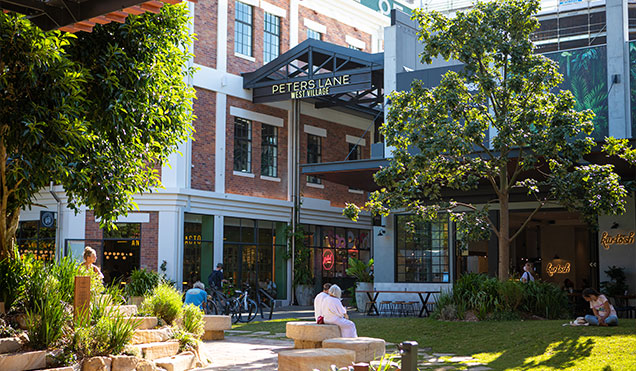West Village is a Six Star Green Star Community. This is Australia’s highest rating for a master-planned precinct and promotes practices which are sustainable and environmentally friendly.
Sustainability

Grey Water Treatment Plant
West Village has a grey water treatment plant on site. The grey water (from laundries and showers) is sourced from two of the precinct’s residential buildings. The treated water is used to irrigate gardens and for flushing toilets in the retail centre.
Reducing Food Waste
Collecting food waste and unsold food at West Village means that most of the food waste from the precinct (up to 85%) gets reused or composted. This is better for the environment than sending food waste to landfill where it breaks down and emits gases such as carbon dioxide and methane which contribute to climate change.
Compostable Packaging
West Village dining outlets are encouraged to use take away packaging which can be composted or recycled. Food waste and compostable packaging from West Village stores and dining outlets is collected and processed through our organic waste pulping system.
Organic Waste Pulping System
West Village has an on site organic waste pulping system. The Pulpmaster Australia system converts organic materials into soils and fertilisers, minimising the use of water and power during the process.
Renewable Energy
West Village generates some of its own energy from the sun. A 23.5 kW solar power system on the roof of The Eaves building near The Common provides some of the power to light our public spaces. Solar panels on residential buildings provide power to shared building services.
Green Spaces
In an urban environment like Brisbane, a “heat island” can be created when materials such as bitumen and concrete absorb and hold the sun’s heat rather than reflect it. To counteract the heat island effect at West Village, around half the site plan is covered with materials which reflect heat, water features or green spaces. Around 100 mature trees and more than 10,000 plants are growing at West Village.
Sustainable Transport
Public bike racks are located in several locations at West Village. Four electric vehicle charging stations and a GoGet car share service are located on Basement 1 in the public West Village carpark. An End of Trip facility provides showers, lockers and secure bike parking for tenants and staff.
Butterfly Food Source
The Richmond Birdwing Butterfly Vine, species Pararistolochia praevenosa, is grown in several locations at West Village. This vine is the natural food source for the Richmond Birdwing Butterfly, species Ornithoptera richmondia. The Richmond Birdwing is the largest sub-tropical Australian butterfly. It is now a vulnerable species. Growing the Butterfly Vine at West Village could help to increase the population of this beautiful butterfly.

Village Bees
West Village is home to up to seven bee hives including native stingless bees and European honey bees. The bees help to pollinate the 3,000 native plants at West Village, while playing a role in supporting biodiversity (lots of different types of plants, animals and micro-organisms) in the direct local urban environment.
West Village partners with Brisbane social enterprise group Bee One Third. Their apiarists (bee keepers) use traditional beekeeping methods to care for our bee population.
Six Star Green Star Community
West Village is a Six Star Green Star Community. This is Australia’s highest rating for a master-planned precinct and promotes practices which are sustainable, environmentally friendly and support engagement with the community.









